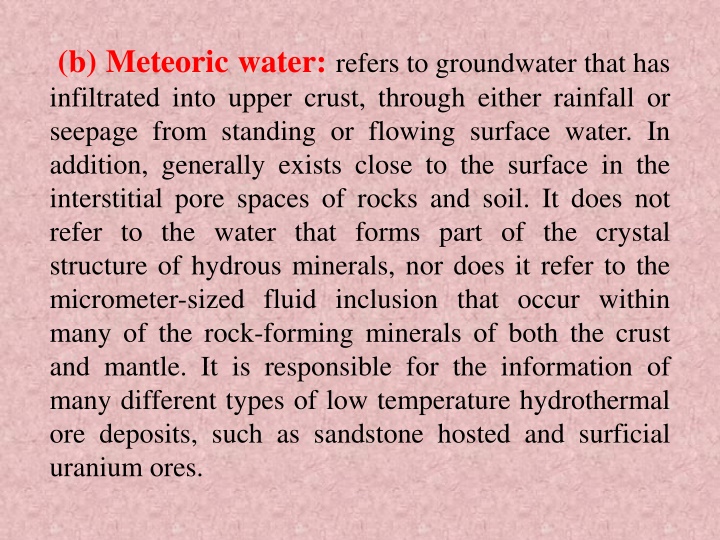
Different Types of Geological Waters
Explore the characteristics and origins of meteoric water, connate water, bond water, and metamorphic water in the context of geology and ore deposit formation. Learn how these different types of water interact within the Earth's crust and contribute to the formation of various mineral deposits. Discover the significance of water of mixed origin in hosting ore-bearing hydrothermal fluids and its role in metal precipitation processes.
Download Presentation

Please find below an Image/Link to download the presentation.
The content on the website is provided AS IS for your information and personal use only. It may not be sold, licensed, or shared on other websites without obtaining consent from the author. If you encounter any issues during the download, it is possible that the publisher has removed the file from their server.
You are allowed to download the files provided on this website for personal or commercial use, subject to the condition that they are used lawfully. All files are the property of their respective owners.
The content on the website is provided AS IS for your information and personal use only. It may not be sold, licensed, or shared on other websites without obtaining consent from the author.
E N D
Presentation Transcript
(b) Meteoric water: refers to groundwater that has infiltrated into upper crust, through either rainfall or seepage from standing or flowing surface water. In addition, generally exists close to the surface in the interstitial pore spaces of rocks and soil. It does not refer to the water that forms part of the crystal structure of hydrous minerals, nor does it refer to the micrometer-sized fluid inclusion that occur within many of the rock-forming minerals of both the crust and mantle. It is responsible for the information of many different types of low temperature hydrothermal ore deposits, such as sandstone hosted and surficial uranium ores.
(c) Connate water: Tow sources: 1- Pore fluids: water that is included within the interstitial pore spaces of sediment as it deposited, referred to as connate or formational water. Originally this water is either meteoric or seawater, but it undergoes substantial modification (increases in density and salinity) as the sediment is buried, compacted, and Lithified. * Increase in salinity sometimes relates to interaction of connate waters with evaporitic horizons, which contain easily dissolvable minerals such as halite, sylvite, gypsum and anhydrite. * Uncompacted particles of sediment when Lithified to form sedimentary rock produce aqueous solutions that evolve with time and depth and are often involved in the formation of ore deposits .
2- Bond water: water that occurs either as loosely bound H2O or OH- molecules within clay mineral particles in argillaceous sediments. ** geothermal gradient varies typically between 15 and 40oC/Km. (d) Metamorphic water: Dehydration and decarbonation reactions during prograde metamorphism are very important processes that produce volumes of metamorphic water in the mid and lower crust.
(e) Water of mixed origin: * Mixing of ore-bearing hydrothermal fluids is important for the precipitation of metals from such solutions. Magmatic and meteoric waters, for example, often undergo mixing at the volcanic to sub volcanic crustal levels associated with porphyry copper and epithermalAu-Ag ore-forming environments. * Mixing of connate and meteoric waters in sedimentary basins forming in continental rift environments promote the precipitation of metals from ore-forming solutions. Figure(4) represents the stable isotopic composition of the above types of origins and therefore uses to deduce the origin of the fluids of the ore-deposits.
